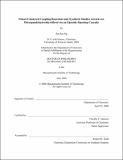Nickel-catalyzed coupling reactions and synthetic studies toward ent-dioxepandehydrothyrsiferol via an epoxide-opening cascade
Author(s)
Ng, Sze-Sze
DownloadFull printable version (13.50Mb)
Other Contributors
Massachusetts Institute of Technology. Dept. of Chemistry.
Advisor
Timothy F. Jamison.
Terms of use
Metadata
Show full item recordAbstract
Nickel-Catalyzed Coupling Reactions. Nickel-catalyzed allene--aldehyde coupling and alkene--aldehyde coupling represent two methods of preparing allylic alcohols. Most asymmetric transition metal-catalyzed methods of preparing enantiomerically enriched allylic alcohols rely on chiral ligands. The nickel-catalyzed allene--aldehyde coupling exploits the axial chirality in 1,3-disubstituted allenes in achieving asymmetric induction. When a chiral allene binds to a transition metal catalyst, the allene establishes a chiral environment around the metal center. This can possibly create a new stereocenter in a coupling product. Indeed, enantiomerically enriched allenes couple with aromatic aldehydes and triethylsilane in the presence of a nickel-carbene catalyst to provide selectively a Z-allylic alcohol with an enantiomeric excess identical to that of the starting chiral allene (eq 1). There is considerable interest to prepare allylic alcohols from simple alkenes because of their wide availability and ease of handling, as compare to alkenyl metal reagents, which are most commonly used to obtain allylic alcohols. It was reported in literature that a nickellacycle could be obtained from a mixture of nickel, a,?-enal, and a silyl triflate. Under appropriate conditions [beta]-hydride elimination could occur to provide an allylic alcohol product. The nickel(0) catalyst could be regenerated in the presence of a base. Ethylene and terminal alkenes are appropriate substrates for this transformation (eqs 2 and 3). Either allylic or homoallylic alcohol product can be obtained from terminal alkenes by using appropriate ligands for the nickel catalyst (eq 3) ... Synthetic studies of ent-dioxepandehydrothyrsiferol via an Epoxide-Opening Cascade Dioxepandehydrothyrsiferol is a marine polycyclic ether natural product isolated from the red algae Laurencia viridis. (cont.) Synthesis of the fused six-seven-seven cyclic ether in entdioxepandehdyrothyrsiferol through an epoxide-opening cascade strategy was explored. Formation of the strained tetrahydropyran ring in ent-dioxepandehdyrothyrsiferol directly from an epoxide-opening cascade of triepoxide allylic alcohol proved to be difficult. Alternatively, a d-lactone was obtained using an epoxide-opening cascade of triepoxide tert-butyl ester. The furan side chain was installed via a Suzuki coupling.
Description
Thesis (Ph. D.)--Massachusetts Institute of Technology, Dept. of Chemistry, 2008. This electronic version was submitted by the student author. The certified thesis is available in the Institute Archives and Special Collections. Vita. Includes bibliographical references.
Date issued
2008Department
Massachusetts Institute of Technology. Department of ChemistryPublisher
Massachusetts Institute of Technology
Keywords
Chemistry.